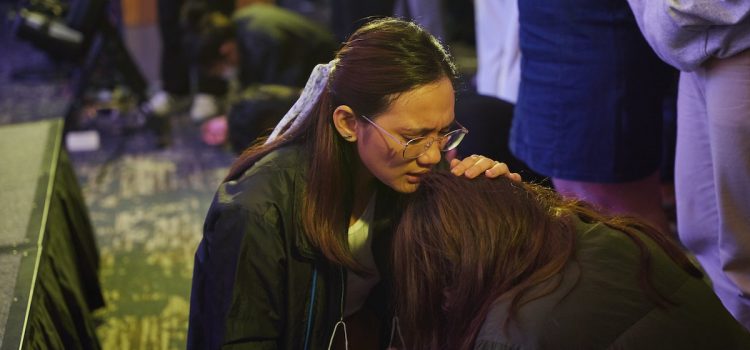

This article is an excerpt from the Shortform book guide to "Men Explain Things to Me" by Rebecca Solnit. Shortform has the world's best summaries and analyses of books you should be reading.
Like this article? Sign up for a free trial here.
Why are female sexual assault statistics high in America? Where is sexual assault and rape most likely to happen?
As of 2014, Rebecca Solnit estimated that tens of millions of women are raped in America every year. Further, she notes that sexual assault and harassment tend to happen in workplace or educational settings where victims are sometimes held accountable for preventing these instances of violence.
Learn more about why the statistics for female sexual assault are so high in America.
Sexual Assault, Sexual Harassment, and Rape
According to female sexual assault statistics, rape is reported every 6.2 minutes—but since most rapes go unreported, Solnit suggests that it’s possible a rape occurs every minute. Sexual harassment and assault are similarly prevalent, and Solnit notes that these in particular often occur in organizations like colleges and universities, workplaces, and the military. In America, 20% of all women are rape survivors; nearly 20% of female college students experience sexual assault; and Leon Panetta—the former Secretary of Defense—estimated that in 2010, nearly 20,000 soldiers were sexually assaulted by other soldiers, with the perpetrators rarely facing punishment. Despite the scale of the problem, rapes are often poorly investigated, if they’re investigated at all—Solnit states that the backlog of untested rape kits in America is nearly half a million.
Rape can also give men continuing power over women, since it can result in pregnancy. Solnit notes that there are 31 states in which rapists have parental rights over the children who result from their violence. This predicament is further compounded by the fact that many politicians have been pushing anti-abortion legislation, including bills that could allow a rapist to sue their victim for having an abortion.
Additionally, the burden for preventing male violence tends to be placed on the victims rather than the perpetrators, explains Solnit. Colleges, for example, often respond to sexual violence by trying to teach women how to avoid being assaulted, rather than trying to teach men not to assault.
(Shortform note: Research suggests that participating in programs devoted to teaching women how to avoid being assaulted can reduce an individual’s risk of being assaulted. However, there’s little evidence that it reduces the overall rate of sexual assault. Critics suggest that such programs are essentially saying to women that they should make sure they’re not the one who gets raped, meaning that other women are still at risk.)
| Social Hierarchies and the Legal System Sexual violence may be prevalent in hierarchical institutions like colleges, workplaces, and the military because people who value social hierarchies are more inclined to side with perpetrators over victims. A hierarchical worldview enables sexual violence by prioritizing the rights of the powerful over the less powerful, and these institutions are heavily populated by people who hold such worldviews. Additionally, women in more vulnerable social positions (such as college students who are new to campus) are more likely to be targeted for sexual violence. The majority of campus rapes occur in the first four months of the school year, and first-year students are particularly vulnerable—close to 17% of female students report being raped in their first year of college. Similarly, in the military, most sexual harassment is carried out by someone in the victim’s chain of command—meaning a person in a higher position of power is preying on someone more vulnerable. And the legal system, the authority that’s supposed to protect vulnerable people from such violence, frequently fails victims. Despite the high numbers of sexual assault in the military (in 2018, an estimated 20,500 sexual assaults occurred in the military—13,000 against women and 7,500 against men), research suggests that the rate at which the military prosecutes sexual assaults is declining: The number of investigated cases that led to criminal charges dropped from around 70% in 2012 to less than 40% in 2022. The US legal system seems stacked against victims of sexual assault in many ways. For example, even in some states that restrict rapists’ parental rights, the perpetrator has to be criminally convicted before the state revokes their parental rights. Additionally, police—those tasked with enforcing the law and investigating rapes—perpetuate the problem in many ways. First, they’re frequently the perpetrators of sexual assault: A 2010 study showed that the rate of sexual assaults committed by police officers was twice the rate of sexual assaults committed by the general population. Second, they can be unreliable investigators: Police dismiss 20% of rapes reported to them as unfounded. And third, women are underrepresented in their ranks: Over 80% of police officers are men. We see patterns of male power in higher levels of legislation, as well: Women hold less than 30% of the positions in the US Congress. And in 2022, Roe v. Wade—the 1973 Supreme Court decision that guaranteed the right to an abortion—was overturned. All of these factors reinforce the power that men can exert over women through sexual violence, which results in things like coercive pregnancies that trap women in unsafe or abusive relationships. |

———End of Preview———
Like what you just read? Read the rest of the world's best book summary and analysis of Rebecca Solnit's "Men Explain Things to Me" at Shortform.
Here's what you'll find in our full Men Explain Things to Me summary:
- How "mansplaining" comes from a cultural tendency to devalue women
- The attitude of control that motivates the mistreatment of women
- The role that language plays in the advancement of women’s rights






